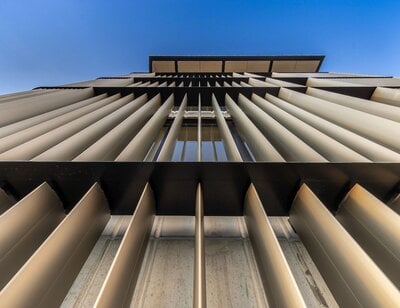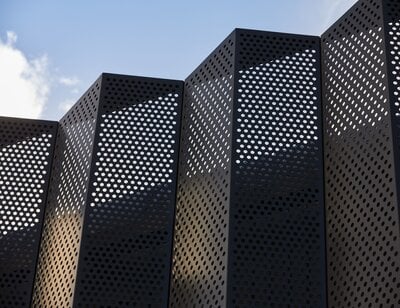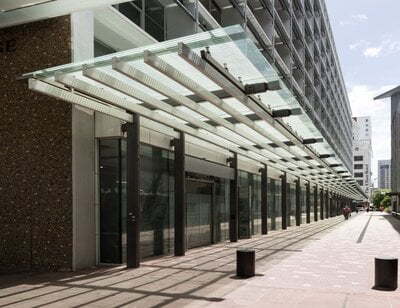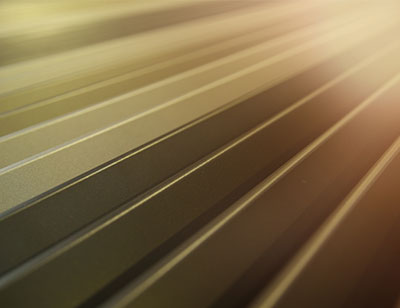We often get asked how we are going to allow for thermal expansion in our louvre designs.
The honest truth is that we rarely need to allow for it – but let us explain.

Unfortunately, there isn’t a relevant industry standard that we can use, but we always carefully analyse two basic points. This analysis quickly determines whether there’s a need to allow for thermal expansion in your design.
Have a facade or louvre design that needs analysis from an expert? Share your plans with us to receive advice from an Insol design engineer. Find out more here.
The points we look at are:
1. How much expansion would you expect?
AS/NZS1664 states that the coefficient of expansion shall be taken as 0.000023/°C.
So, the formula for calculating thermal movement in aluminium looks like this:
length (mm) x 0.000023 x temperature change °C = thermal movement (mm)
So for a 4m length with a temperature change of 40°C:
4000 x 0.000023 x 40 = 3.68mm
It pays to note that the °C of temperature change is metal temperature not air temperature. Metal temperature variations can differ widely from air temperature depending on colour, so this is important to consider.
So, if you’re designing an extruded kitchen drawer handle that is 100mm long and not likely to experience more than 10°C temperature change, then expansion won’t be an issue for you. However, if you’re designing an external vehicle component that could be painted black and used in areas with extreme temperature variations, start thinking about how you’re going to design around the movement.
/1.Products%20(Incl.%20Imagery%20%26%20Technical%20Files)/Product%20Galleries%20Tabs%20(Images%20%26%20Project%20Profiles)/Aurora%C2%AE%20Sunshading/Aurora%20Louvre%20Invercargill_10-83300_hi-res.jpg?width=592&height=444&name=Aurora%20Louvre%20Invercargill_10-83300_hi-res.jpg)
2. What are the consequences of the movement?
Thermal movement is a hugely powerful force, which can damage your design if it is not accommodated for appropriately.
Consider some of the following:
- Will it shear bolts that are securing it?
- Will it cause permanent damage to something else?
- Will it compromise the integrity of a weathertight envelope?
- If there is no room for it where will it go? If thermal expansion has nowhere to go it can cause long lengths of aluminium to buckle leading to permanent damage.
- If thermal expansion were to compromise the integrity of structural fixings, what are the consequences of failure?
Now, to apply these two points to aluminium louvres and other sunshade structures.
Louvres are not normally part of the weathertight envelope like roofing, cladding, or windows. They are normally wholly exterior elements with space to move and good airflow all round which helps reduce the temperature change. However, because louvres are external, could be dark in colour, and could be located in areas of extreme temperature variation; they still have the potential to experience high thermal movement and still need to be treated carefully.
Let’s take a look at some non-issue louvres before we look at some critical ones:
- Motorised louvres - these are normally 4m or less so the movement is small. They also have axels at each end and a minimum operating clearance that is greater than the expansion. Consequently there is no need to make special allowance for thermal expansion.
- Open ended louvre installations with rear mounting details - such as our clasp bracket system. Our clasp system is designed to tolerate a certain amount of lateral movement and flex to accommodate site tolerances. This also accommodates movement from thermal expansion even on longer louvers.
The two most critical points to look for are these:
- Long louvres fixed tight between structural elements that will not flex. We have seen louvres (not ours) fitted into openings in precast concrete that did not have any tolerance at the ends. The few millimetres of expansion longitudinally, had translated into a significant amount of lateral buckling resulting in permanent deformation. They were a dark colour and must have been fitted tight when it was a cold day.
- Long lengths of aluminium direct fixed to a different material such as precast concrete or steel. This can lead to the expansion forces shearing the heads off the fasteners with potentially catastrophic consequences.
In summary, louvres are typically low risk items and thermal expansion issues are negligible. But be careful! There are some situations that require good design allowances for thermal expansion, and it pays to understand first principles when designing these items.









